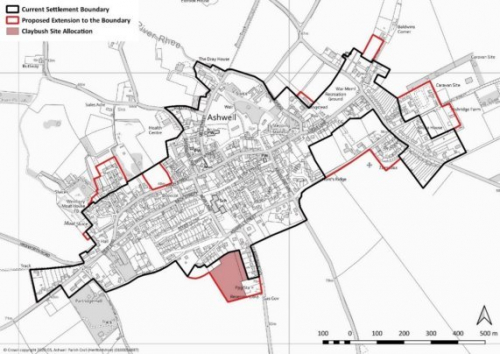Ashwell Neighbourhood Plan Regulation 16 Submission
4 Spatial strategy
4.1 The Emerging Local Plan classifies Ashwell as a 'Category A village'. Together with Category B and C villages, these settlements are expected to make provision for 9% of the housing need across the district. Since 2011, 86 homes have been built in Ashwell. The Emerging Local Plan seeks to allocate one site in the parish (Claybush) for an estimated 33 homes, though in September 2019 NHDC granted planning permission for 30, bringing the total since 2011 up to 116.
4.2 Ashwell is a rural parish with one central village, which has a high proportion of nationally listed buildings. It is important that any development reflects the size and character of the settlement in terms of density and form and character. It is also important that development is directed to appropriate locations, principally locations within the village where development can be conveniently located to access local services and facilities. Sprawl is to be avoided.. This is best achieved by defining a development boundary, within which development is deemed appropriate.
4.3 The Emerging Local Plan redefines the settlement boundary for Ashwell to indicate the area within which further development will be allowed thereby enabling Ashwell's development needs during the Local Plan period to be met. It is also a realistic limit beyond which expansion would compromise the sustainability of the village, according to the three NPPF objectives: economic, social and environmental. Both the Saved Plan 1996 (current) boundary and the Emerging Local Plan (proposed extension) boundary are shown in Figure 4.1.
4.4 Responses to the 2015 Housing Survey conducted for the ANP indicated an overwhelming preference for infill in the village and brownfield development across the Parish before any open spaces in the village or across the Parish are exploited. Within the development boundary, the Emerging Local Plan allows general development (subject to it conforming to other policies) so infill can only be a preference. However, outside the boundary, brownfield status should be a requirement, subject to the Emerging Local Plan policies relating to Land Beyond the Green Belt: CGB1 Rural Areas beyond the Green Belt; CGB2b Community facilities, services and affordable housing in the Rural Area Beyond the Green Belt; and Policy CGB4: Existing buildings in the Rural Area Beyond the Green Belt.
Policy ASH1 Location of development
Summary
Building on land that has already had some form of development, before exploiting greenfield sites, is preferred, but also subject to relevant policies and design guidelines .
Proposals to build outside the boundary are subject to rules similar to those that protect the Green Belt...
Full policy
(2) POLICY ASH1 LOCATION OF DEVELOPMENT
- Development in the ANP area will be focused within the proposed extension to the settlement boundary shown in Figure 4.1 , subject to all relevant policies in the ANP, Emerging Local Plan and NPPF (February 2019).
- Within the proposed extension to the settlement boundary, proposals that make use of brownfield land will be supported. Development on greenfield land while there is available brownfield land will not be supported.
- Development proposals outside the proposed extension to the settlement boundary shown in Figure 4.1 will not be supported unless:
- it is in accordance with Saved Plan (1996) and Emerging Local Plan policies in respect of appropriate uses in the countryside; or the development preserves or enhances the character or appearance of the area; or
- where relevant, the development brings redundant or vacant historic buildings back into beneficial re-use; or
- it relates to necessary utilities infrastructure and where no reasonable alternative location is available; or
- it is on sites allocated for those uses in the North Hertfordshire District Council Local Plan or its successor.
Conformity reference: NP Objectives: 1; Saved Plan 1996: 7, 25, 26, 29 Emerging Local Plan SP1, SP2, D2; NPPF (2019): 8, 16, 17, 24, 28, 117, 118

